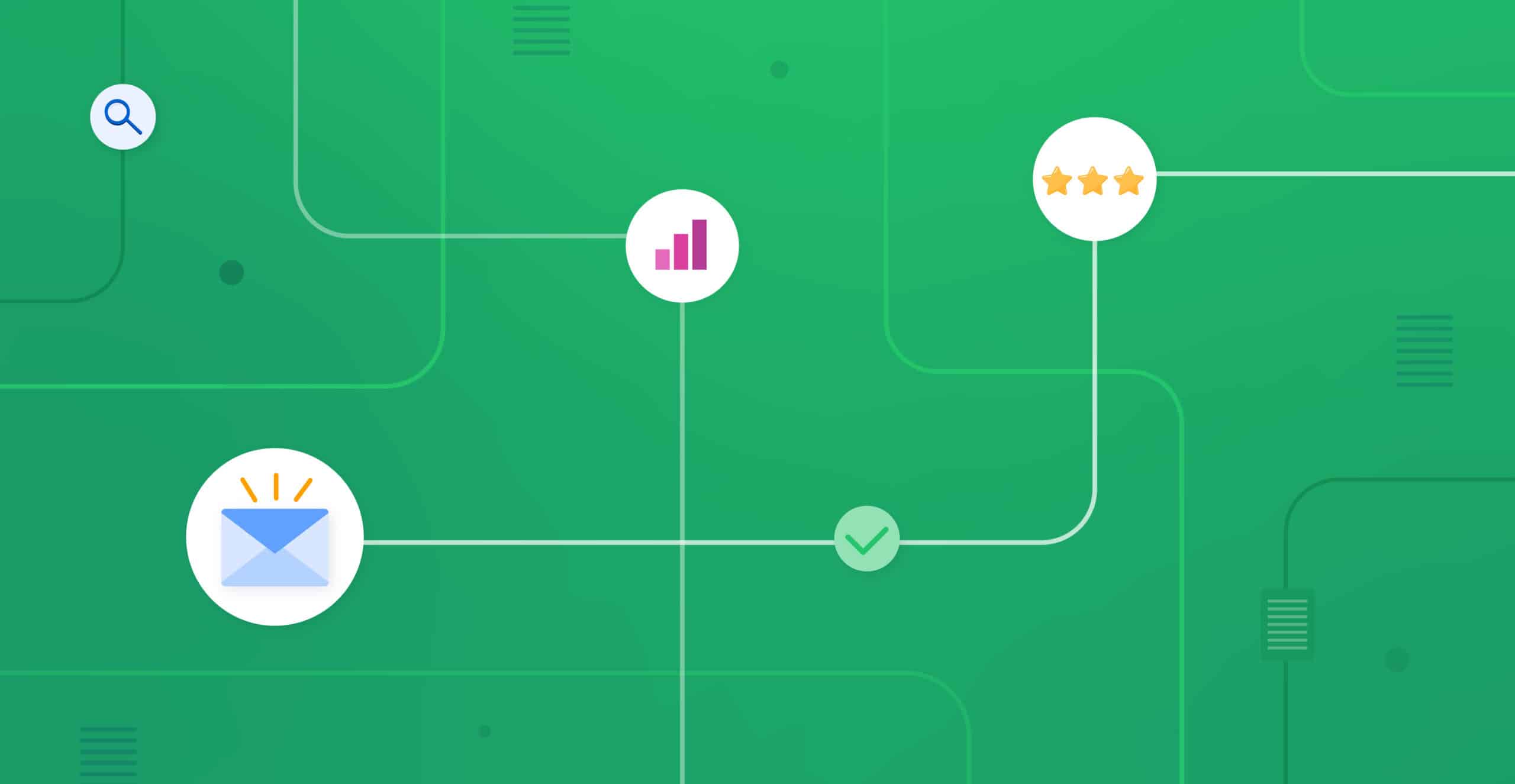What is task automation?
Task automation uses AI-based software to streamline repetitive work. Great task automation eliminates errors and miscommunication, creating transparency around the many goals and activities happening inside a company. Task automation is like wading in the pool’s shallow end–a great place to begin before diving into the deep end of automation.
Why automate tasks?
Automating tasks is integral to scaling a growing business. With more employees and processes than ever, task automation simplifies communication, reduces costs, and makes room for more creative, value-add work.
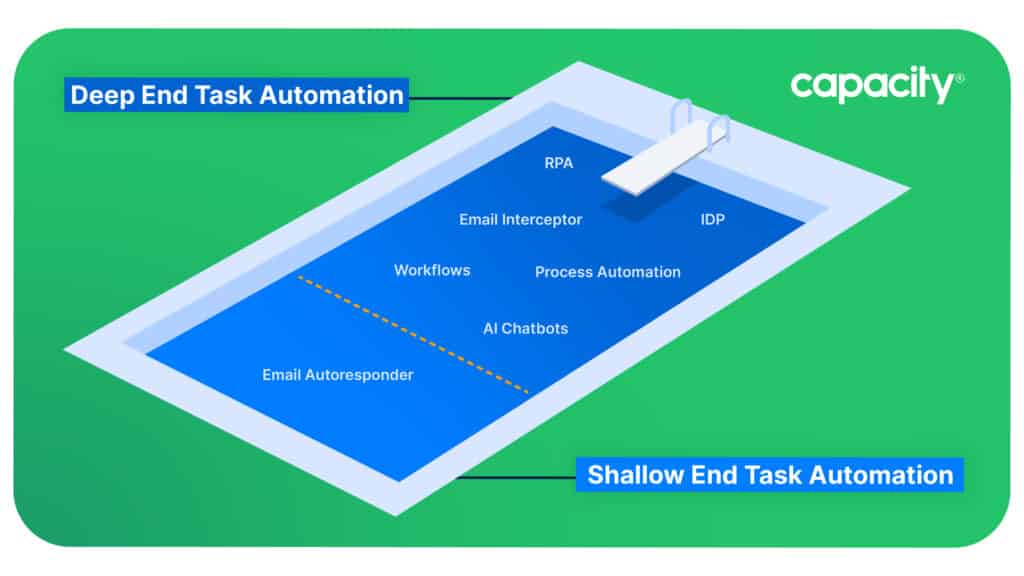
5 examples of task automation
Workers have been fighting the mind-numbing task battle since the assembly line era. And sure, work has evolved since then, but we still run into “assembly line” problems. Fear not, because task automation can solve a lot of these issues. Here are 5 to get you started.
1. Email Task Automation
A vacation autoresponder is the perfect example of simple task automation. Think of this as a “shallow end” task. On the other end of the pool is automation software that can deflect, answer, or route emails to the right person. This “deep end” task automation, known as “email interceptor,” provides the sender with the correct response at the right time and reduces the volume of emails. This type of task automation is an excellent place for email-heavy businesses to start.
2. Bring Task Automation to Customer Support
Many organizations rely on traditional helpdesks to respond to customer questions. Some of these tools have some light task automation built into them, but they lack the power of true task automation, leaving tickets and emails to pile up as volume increases.
As the ticket queue grows, pressure builds for customer support teams, leading to burnout, customer churn, and rising costs. According to Forbes, companies that embrace task automation can save anywhere from 40 to 75%. Shifting to an automated helpdesk stops over 90% of FAQs before they ever reach customer-facing workers. Automating Tier 0 and Tier 1 customer support ultimately creates happier customers and proactive vs. reactive support teams.
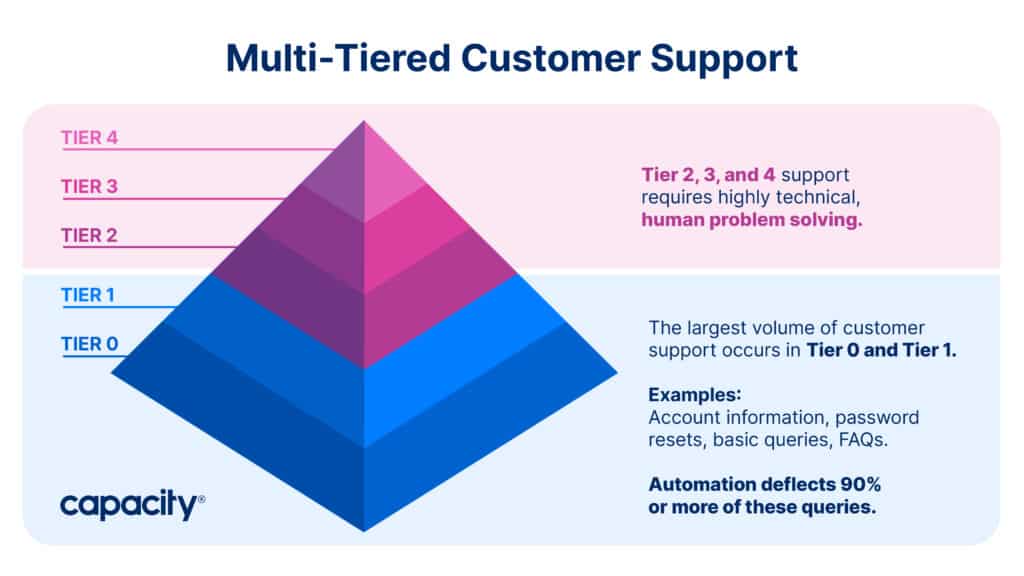
3. Internal Teams & Task Automation
People have a lot going on, and no one knows that better than HR teams. Every employee interacts with HR teams, and with the shift to remote, hybrid, or in-person work, it’s easy for internal communication teams to feel overwhelmed. According to SHRM, HR professionals report record-high burnout, citing a lack of time, increased responsibilities, and well-established challenges like onboarding, training, and retaining employees.

When we spoke with Jenny Fritz, the Experience Manager at Capacity, she shared that “HR teams are the ‘paper pushers’ in an org. That includes forms, new hire documents, benefits enrollment, handbook and policy renewals that require employee acknowledgment. Organizing and automating that chaos in one platform like Capacity is a big win for HR teams.”
She continues, “when we think about communication with the broader team, being able to easily update those communications directly through one platform without having to fumble across other platforms or email, and setting expiration dates for said information is a huge win.” Ultimately, this builds trust between employer and employee by creating a sense of belonging through shared knowledge.
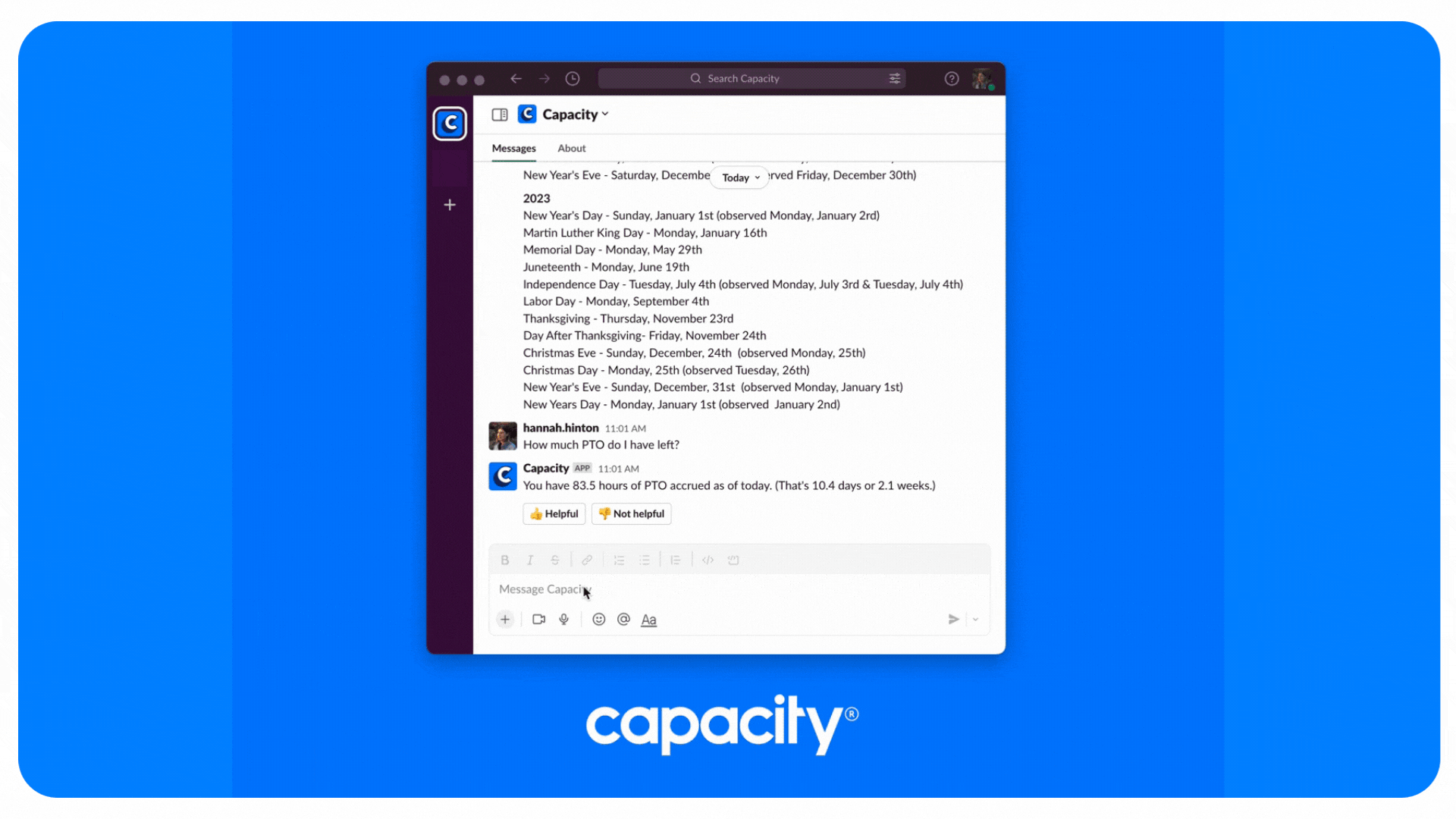
4. Marketing & Sales Task Automation
Everyone wants to know the health of their company. Many marketing and sales automation tools manage leads, but they are often in disparate systems that members outside these functions can’t access.
Task automations like sending leads or creative requests directly to Slack, Microsoft Teams, or wherever teams communicate keep Marketing and Sales teams aligned. This type of task automation is a great first step toward transparency around these two oft-siloed parts of the business. Task automation creates room to improve how revenue teams communicate both challenges and wins.
5. Finance Task Automation
Finance and Administrative departments are often the most inundated with tasks.
Automating invoicing is a great place to start, as it enables contractors and vendors to get paid faster, building trust and reducing the chances that an invoice slips through the cracks. Other opportunities for finance automation include payroll, expense reporting, and more. As with any task automation, choosing the right place to start means beginning with business goals in mind and ending with task automation.
Task Automation: Common Challenges & Solutions
As businesses mature and employees come and go, challenges can arise. Here are some common task automation challenges and how to overcome them.
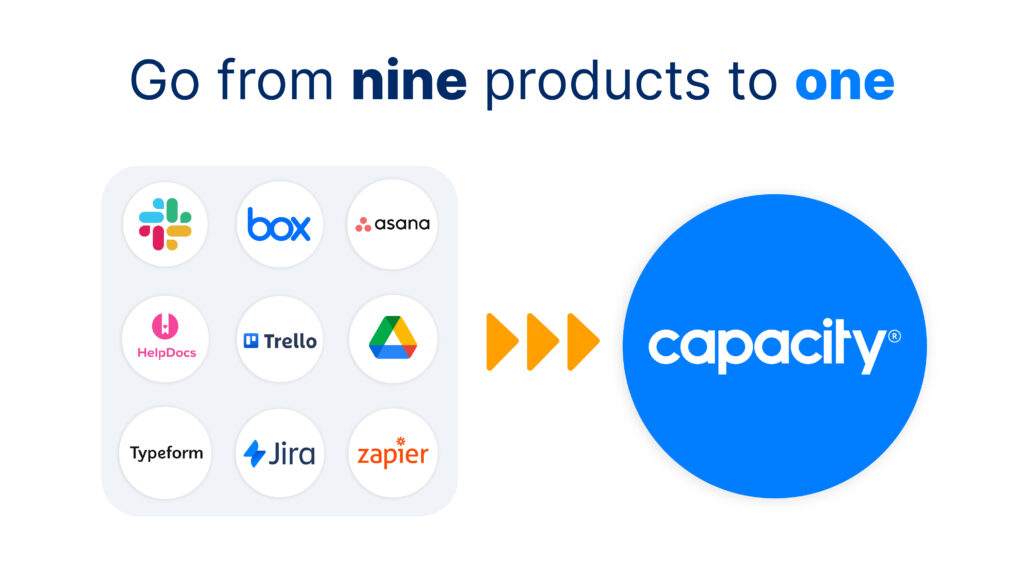
Problem: Tool Overload
As leaders begin thinking about bringing task automation to their organization, the sheer number of tools out there can feel overwhelming. Every department, from Customer Service to HR and Sales, have different needs, so planning with stakeholders from every team is a must, or you’ll end up with fragmented tools that don’t talk to one another and become more trouble than they’re worth.
Solution: One Task Automation Platform
Unifying teams under one task automation platform eliminates the need for separate tools, creating one place to automate and build. With everyone dedicated to one system, teams stay aligned and uncover task automation capabilities to transform their org.
Problem: Super Complex Workflows
Every business has one big, hairy complex workflow requiring multiple employees’ expertise. As workflows grow, it’s easy to miss a required step crucial for the workflow to finish. When complexity meets humans, the chance for errors skyrockets.
Solution: Simplify while Launching Task Automation
One of the best reasons to bring task automation to your organization is to uncover processes that are outdated and in need of a refresh.
Example of a Workflow:
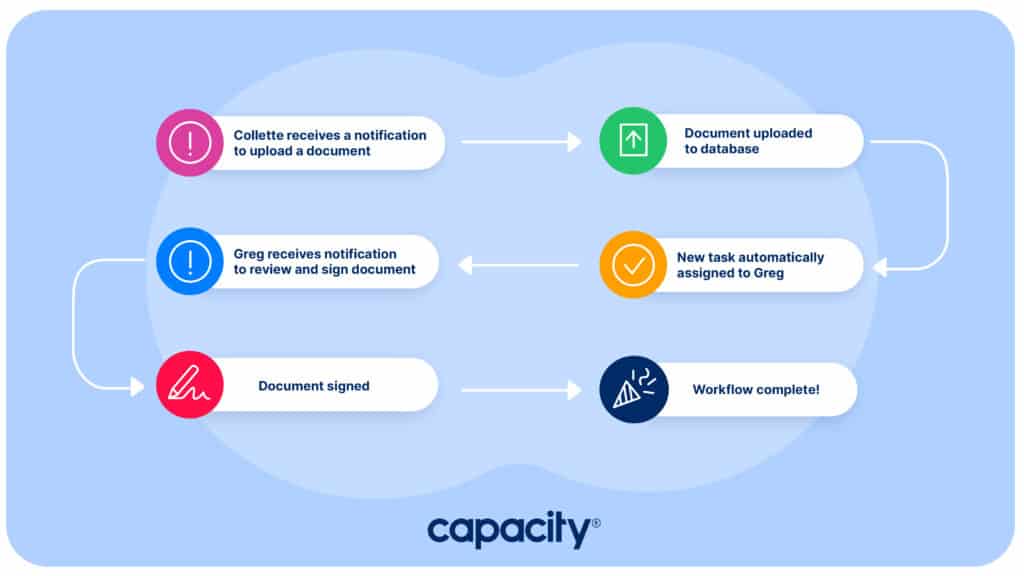
Problem: Employee Buy-In
As with any new software, pushback from employees is going to happen. And that’s perfectly fine. We all have our favorite SaaS platforms, which can create uncertainty and worry. Automation and AI often scare employees because it creates undue concern around job security. However, with the right approach, getting buy-in can feel collaborative and assuage many of these fears.
Solution: Get Buy-In Upfront
Before choosing what tasks to automate, gather all stakeholders together and decide what tasks need automation. You know the mission-critical workflows and functions, but including each stakeholder creates a culture of collaboration. As you identify these, you can move forward with an implementation plan before you start searching for software, including getting buy-in from leaders and support teams. Some of these might include the following:
• Piles of backlogged support tickets
• Wasting time trying to find data and documents
• Answering the same questions over and over again
4 Benefits of Task Automation
Task automation can help alleviate pressure on teams, including cost savings and scalability. Here are a few essential benefits to keep in mind:
Reduce Costs with Task Automation
While implementing a task automation solution sounds costly, it can save you thousands. Nearly half of organizations spend $100 or more per hour on customer support. As customer expectations continue to rise, customer support costs grow. Automating tasks lowers overall costs and reduces human errors.
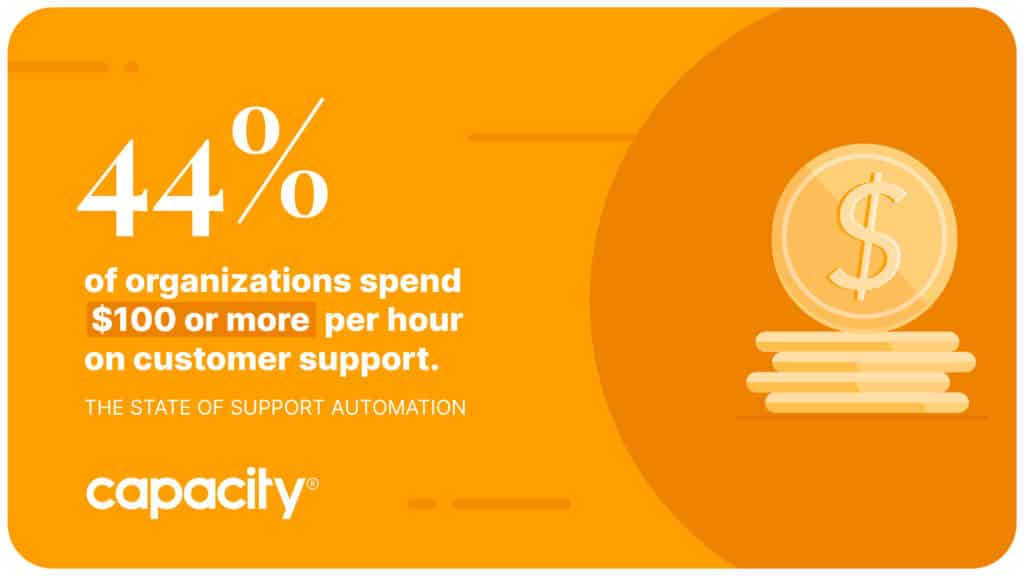
Focus on Automating Strategic Tasks
It can quickly add up when you think about all the repetitive tasks employees perform daily. Task switching lowers your ability to produce quality customer service and work. Task automation solutions handle the tedious work, freeing teams to focus on more critical objectives.
Optimize & Scale with Task Automation
Task automation destroys roadblocks, allowing teams to do more work in a shorter amount of time. Think about task automation as your personal assistant. It automatically sends data directly to you, ensuring complications are minimized. As more and more tasks become automated, teams can grow, expanding on more strategic goals.
Increase Customer Satisfaction
Customer expectations continue to rise, and support teams need proper technology to meet demand. With task automation, teams have more time to spend on customer-based initiatives, ultimately improving the overall customer experience. Happy customers typically lead to happy support teams.
6 of the best task automation software tools
1. Capacity
Capacity’s platform answers over 90% of external customer and internal team member questions within seconds.
Encompassing task automation, helpdesk, and AI-powered chatbot technology, Capacity prevents tedious tasks from hitting your team’s inbox or queue. Capacity empowers customers and team members to find answers quickly through self-service, freeing support teams to focus on strategic work.
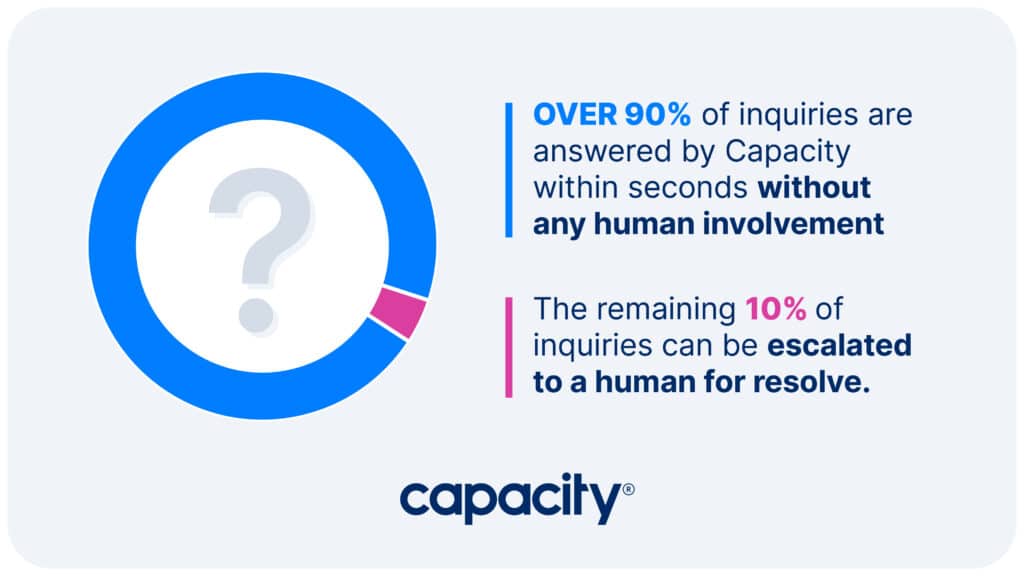
2. Zapier
Zapier is a product that focuses on simple task automation. End users can integrate with their web applications and automate basic workflows.
3. Asana
Asana is a project management tool that helps teams organize tasks and workflows. Users can use kanban boards to stay updated on essential projects.
4. Service Now
ServiceNow is a cloud computing platform that helps companies manage digital workflows for enterprise operations.
5. Jira
Typically used by IT teams, Jira is an issue-tracking product developed by Atlassian that allows bug tracking and agile project management.
6. Click Up
Click Up helps teams organize tasks in an easy-to-view environment, allowing users to project manage tasks and projects.
Capacity is your task automation platform
Finding the right task automation solution can be a challenge. If your business is ready to scale, if your support team is stretched, if you have too many emails and chats hitting a shared inbox, or your helpdesk isn’t cutting it, Capacity can help.
Capacity is not your average task automation tool. We help businesses like Next Move deflect 92% of inbound inquiries, saving employees over 200 hours per week.
Place Capacity on your website or integrate with your most used applications such as Slack, Microsoft Teams, Jira, Salesforce, Canvas, and more. We connect securely with all of your systems.
Whether you need an AI-powered chatbot, an email interceptor, a better knowledge base, or a ticket destroyer, Capacity meets you where you are.


